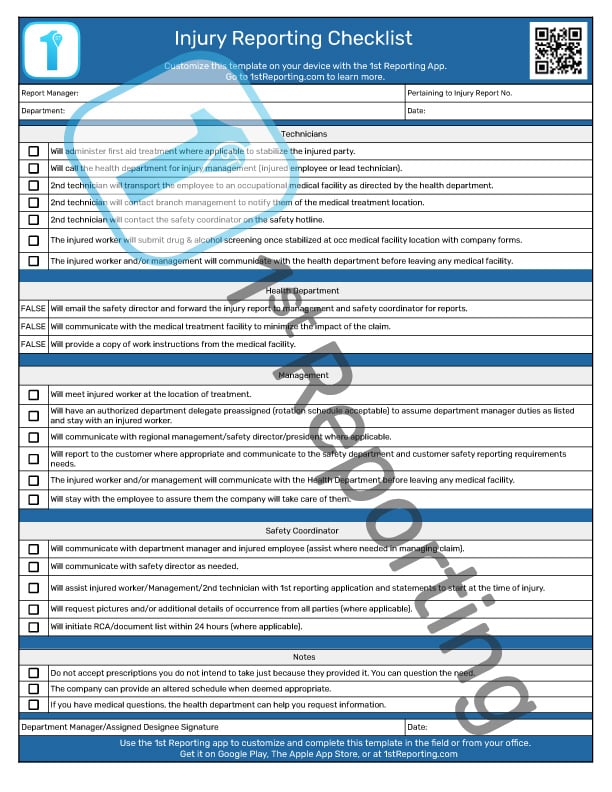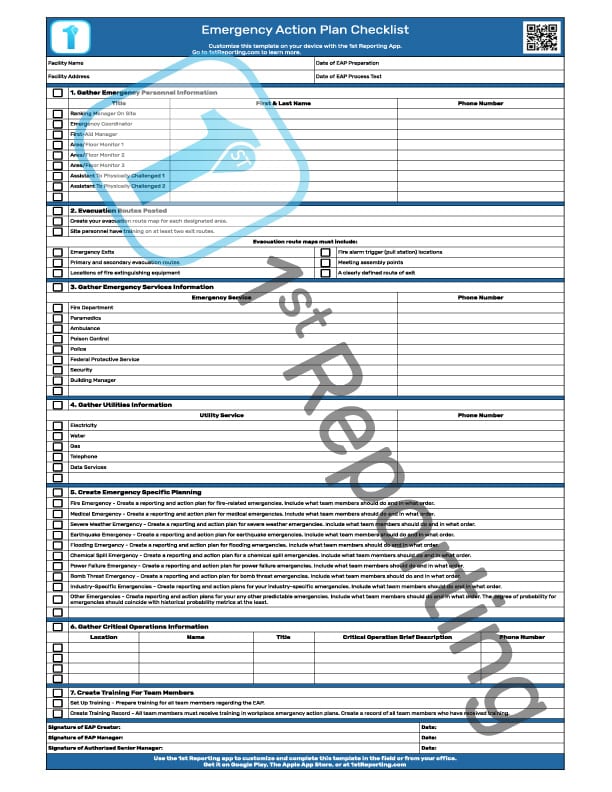
Incidents involving injury can happen in seconds. We all try our best to maintain preparedness and provide procedures for staff to follow if an injury occurs. But does your team know the proper steps? Of course, you’ve provided training, but will the staff remember? In this situation, a procedural injury report checklist is just what the doctor ordered.
We’ve created the injury reporting checklist to aid in the effective remittance of documentation, adherence to protocol, and completion of procedures pertaining to employee injury in the workplace. This downloadable and free checklist will help streamline your corporate injury reporting process and ensure that the steps necessary for proper documentation and management are adhered to when an injury occurs.
In an effort to achieve efficient workflows, we’ll start with a quick explanation of the IRC (Injury Report Checklist). Then we will discuss:
- How to use the Injury Reporting Checklist (IRC)
- Benefits of using an IRC within your corporate environment
- Tips to increase efficiencies with your current reporting processes
- Digital solutions to maximize workflow efficiency (and automate procedures)
Included In The Injury Reporting Checklist
When you view the IRC (Injury Report Checklist), you’ll immediately identify with seven visible sections of the template. These sections include the following data input sections:
- IRC Administrative Data
- Technician(s) General Instructions
- Health Department General Instructions
- Management General Instructions
- Safety Coordinator General Instructions
- General Notes and Considerations
- IRC Completion Sign-Off
Sections one and seven are self-explanatory, providing report document information and sign-off. The other five sections find themselves established per departmental obligation. We see the departments and roles based on standard corporate processes and functions used in various industries to facilitate the injury reporting workflow.
How To Use The Injury Report Checklist
Determining the proper procedure for processing an at-work injury may seem challenging for the uninitiated. Depending on the industry, nature, and severity of the injury, as well as many other factors, the reporting process alone can seem wrought with the peril of incorrect decisions based on a lack of current information.
Retraining staff regularly is an essential tool in your company’s injury management procedure. But when push comes to shove, it can be challenging to maintain a previously implemented policy per the associated steps of said policy.
It is especially true in circumstances where injuries are few and far between. A lack of experience dealing with injury situations can be just as damaging to an injured individual as it can be to a company’s reputation. Therefore, standardized processes and procedures are a necessity in optimizing company process efficiencies and reporting obligations.
Using the Injury Report Checklist to facilitate a standardized injury reporting process becomes essential in a work environment where injuries are either few and far between (the ideal) or have the potential of severity.
The following workflow is a typical use of the injury reporting checklist.
- An injury occurs. The first line of defense engages (technicians) and deals with the immediate care and communication requirements. The first section of the injury reporting checklist body is utilized for this purpose.
- Following the technicians’ communication, the firm’s health department springs into action and begins communications with the safety director, management, and any applicable treatment facility involved. The second section of the IRC body finds use for these steps of the injury reporting process.
- Management becomes involved in the process and meets with the injured employee at the medical treatment facility, communicating with the facility and health department. The manager’s support assures the employee of the company’s care. These steps are outlined in section three of the IRC body.
- The safety coordinator becomes involved and coordinates communications between the injured, management, the health department, and others involved. The coordinator compiles data pertaining to the incident and initiates document creation as required in a timely fashion. In this fourth stage of the IRC, the coordinator has completed and facilitated the coordination of the local, regional, or nationally required government or agency documents.
- Finally, there are some notes of interest regarding the process in the final section of the IRC.
In accordance with a practical and effective process, the IRC follows the trail of an injury report process, including creating an Employee Injury Report.
Benefits Of An Efficient Injury Reporting System

Aside from the obvious legal obligations companies have to report injuries and incidents, utilizing an IRC and a streamlined general injury process may reap a number of benefits.
- A Positive Impact On Employee Relations
Staff respect strong leaders. They appreciate them even more when they know they are supported. The first time an employee injury occurs around staff uninitiated to the process and these staff witness management supporting injured staff, a sense of value is created for their current employment. Staff will work harder for managers and companies who support them in their time of need. The relationships built out of difficult times can make a company an army of loyal employees, positively impacting operations and making management more effective in their core competencies.
- Increased Corporate Synergy
Standardized processes increase corporate synergy; there’s no question. But, combine a well-thought-out strategy standardized and carried out by loyal employees, and you’ve got a winning combination for managing injury reporting processes.
- Lowered Loss Of Revenue From Operational Disruption
When your corporate synergy is high, there is a noticeable increase in business efficiency. Increases in business efficiency pay off when the process is for managing an operational loss like an injury situation. Minimizing operational disruption by utilizing plans for effective management of injuries lowers the company’s potential losses due to operational disruption. Using an IRC to facilitate a standardized and, thus, efficient reporting process reduces the risk of financial loss caused by inefficient or poorly thought out strategies that don’t account for injuries causing operational disruptions.
- Strong Incentive For Safe Work Ethics For Staff
The planned and trained stages of the IRC are a two-fold approach to increasing awareness. First, the employees involved and those who merely hear about the injury process will understand the company is supportive of the employee’s care and well-being.
However, it also shows the employee that they are a valued cog within a giant machine, pushing the team-player mentality. When staff see their peers and management taking so much time to assist the employee, the staff are impressed with the notion that all is best for the team to avoid injuries moving forward.
Including a drug screening test within the process also further incentivizes the employee to avoid injury in the future and ensure they are working safely. In understanding that there may be repercussions for those who defy safety regulations, employees will realize that an accident-free environment is in their own best interests.
Tips For Efficient Injury Reporting Processes
Here are three tips that any corporation can find helpful to increase core competencies and provide a more effective and efficient workflow for injury reporting.
- Injury Reporting Process Standardization
Within every organization, there are processes implemented to organize and streamline company or organizational procedures. Standardizing these processes and implementing training for employees and management alike will increase your company’s injury reporting process efficiency. Standardization is easy when you implement a solution like an IRC template.
- Incident Preparedness And Accident Planning
If you want to avoid costly downtime and, more importantly – employee injury, then you need to have a plan. Accident and emergency planning is a form of preparedness your organization can’t afford to ignore. Within your core competencies should exist the planning and preparing process to ensure that your team is ready to respond to any eventuality.
It can be as simple as maintaining good first aid equipment and keeping staff trained to use such things. Either way, and in any work environment, maintaining a plan and preparedness is essential to increased efficiency in dealing with an employee injury and the incident reporting processes.
- Specific Role and Responsibility Refresher Training
Many corporations tend to stick to the bare minimum when it comes to training staff. Often, the staff is subjected to a lengthy and tedious series of onboarding training videos, most of which are forgotten within minutes and hours of viewing. Ensuring that staff maintains current training is vital. Ensuring that staff knows their roles and responsibilities regarding injury reporting and actions required during an injury-producing incident is also essential to your smooth business operation.
An excellent solution to this typical scenario in the corporate sphere is to provide staff with semi-regular mini re-training sessions to act as reminders of the staff’s roles and responsibilities. Taking a few moments to include emergency roles and procedures for situations such as employee injury can make all the difference between an incident handled efficiently and one that loses more than is necessary due to poor decisions or a lack of knowledge of responsibility.
Digitizing Your Procedures For Maximum Efficiency – A Cost-Effective Solution
Standardizing your processes using templates, forms, and checklists such as the IRC is a significant first step to increasing efficiency and lowering the potential for detrimental liability situations. But what if you could go two steps further and eliminate an entire aspect of the reporting workflow? That’s right, eliminate a complete step by automating it.
This type of automation can increase efficiency exponentially and ensure processes and procedures are followed to the letter.
Using an incident reporting app such as 1st Incident Reporting is one way to leverage technology within your organization and eliminate the risk of procedural ineffectiveness.
The 1st system utilizes custom-set notifications and more to provide your organization with the workflow required when an incident or injury occurs. You can modify the system to send notifications when and where you need them. With actions such as report completion notifications, your team can monitor when an injury report is completed and submitted.
If you include the customizable forms, checklists, and set of default templates provided, you can easily custom-tune the app to fit your business needs.
Whether reporting shift incidents within the security industry or reporting injuries in healthcare, the 1st Incident Reporting application is more than just incident reporting – it’s a solution to automate entire report workflows from incidents to vehicle or equipment maintenance reports and inspections, too. With the benefit of customization, you’ve got everything you need at your fingertips to increase your organization’s reporting efficiencies drastically.
Useful Resources
- The Incident Report And The Disclosure Process
- Downloadable Employee Injury Report
- Incident Report Templates Library
Sources
- https://www.bizjournals.com/bizjournals/how-to/human-resources/2015/05/steps-to-take-when-an-injury-happens-at-work.html
- https://ehsdailyadvisor.blr.com/2016/04/5-tips-for-reporting-severe-injuries-to-osha/
- https://www.ccohs.ca/oshanswers/legisl/injury_reporting.html#:~:text=Immediate%20notification%20can%20be%20made,will%20be%20asked%20to%20provide.
- https://www.osha.gov/report





